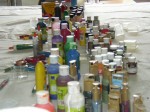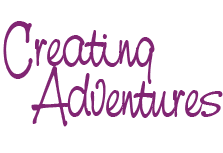 Once a month I convert my sign shop into a play room and host an Art of Being Present play date. The 12-ft table is covered with dozens of bottles of paint and stacks of slick finger painting paper. The CD player is set up with an eclectic selection of music picked specifically to get the listeners moving. Friends, colleagues and business contacts are invited to come over and get in touch with their inner child.
Once a month I convert my sign shop into a play room and host an Art of Being Present play date. The 12-ft table is covered with dozens of bottles of paint and stacks of slick finger painting paper. The CD player is set up with an eclectic selection of music picked specifically to get the listeners moving. Friends, colleagues and business contacts are invited to come over and get in touch with their inner child.
I don’t like calling these workshops. Workshops are something corporate types take to increase productivity, build teams or whatever the newest trend is in the HBR. This experience, when it goes right, is more akin to play. The term “playshop” doesn’t roll sweetly off the tongue though. Play date may more accurately represent what we do but I’m not crazy about that either. Guess I’ll just have to keep working on the language.
Anyway – so far each session has been an intimate group of participants. As few as one, as many as four. One advantage to such small groups is I can blatantly experiment on them. Another bonus – I can paint too instead of spending my time managing the process, paper, and paintings.
At the start of each session I have everyone do a deceptively easy, yet very powerful writing exercise: If there was unlimited time, energy and resources, what would you be, do and have? I ask for the biggest, most unapologetic dreams. Then I cranked up the CD player and ask that everyone express through paint, hands and gesture what it feels like to have those things. To paint as if those dreams are real, right now.
I know that the instruction about painting the feelings drops out of consciousness almost immediately. What happens in its place is a total absorption in the activity – a kind of flow state – and in that state I believe the “be-do-have” is working in the background. Moving from the conscious mind into the unconscious and being expressed in the body through the act of painting. Since there is no expectation to produce “pictures” the creative, intuitive right brain is free to express itself.
I’m working on a way to introduce a “what problem are you stuck on?” exercise to explore whether this activity helps solutions arise from the intuitive mind. If this works it could have applications within the business world. I would love to see an room full of corporate executives or engineers wearing oversized painting smocks and smearing paint around. In that context I guess these would be workshops after all.
There is a deep well of potential within this simple appearing activity. I am so excited to be exploring it and so grateful that I have the opportunity.
Thank you Ruth Faison Shaw for rediscovering the art of finger painting and bringing it to the mainstream.


Wow Kerry! This sounds incredibly fun & therapeutic. What a unique idea. Maybe you can call them “Paint Dates?” lol – Thanks for exposing me to this. Let me know when you’re next one is – would be fun!
Sharon Hiebing
Creating Wealth through Caring & Connecting
http://www.wealthships.com